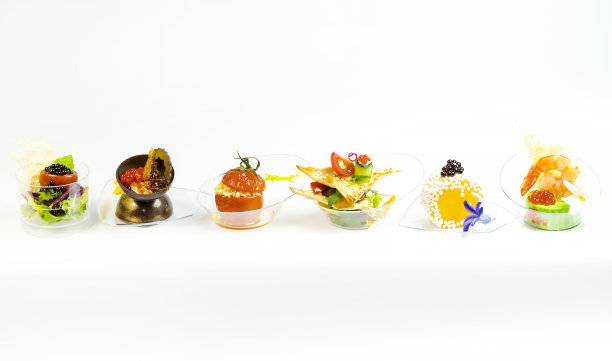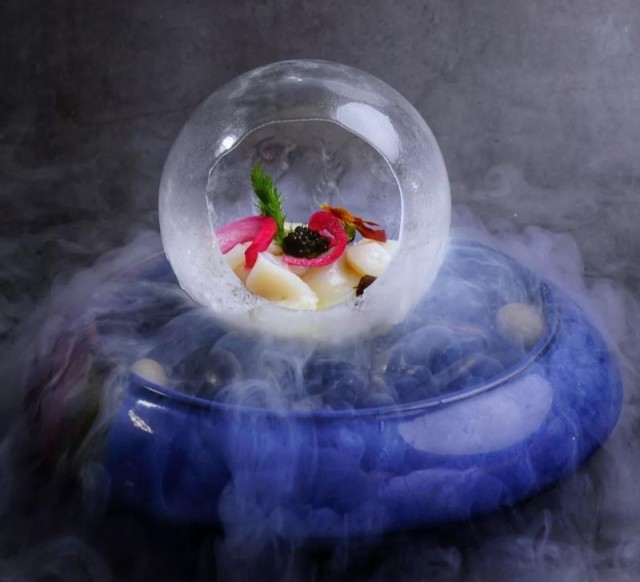Introduction to Molecular Gastronomy
Defining Molecular Cuisine
Molecular gastronomy is a culinary discipline that fundamentally transforms traditional dishes by altering the molecular structure of ingredients. This innovative approach leverages principles from physics and chemistry to engineer new flavors, textures, and shapes, thereby transcending the boundaries of conventional cooking.
In molecular gastronomy, ingredients are not merely cooked; they are meticulously analyzed and manipulated at a molecular level. This scientific rigor allows chefs to create dishes that are not only visually stunning but also offer novel sensory experiences. For instance, a familiar ingredient like olive oil can be transformed into a foam, a gel, or even a powder, each offering a unique texture and flavor profile.
The integration of scientific principles into cooking elevates molecular gastronomy from a craft to a science. By employing techniques such as spherification, emulsification, and sous-vide cooking, chefs can achieve unprecedented control over the final product. This precision not only enhances the dining experience but also opens up new possibilities for culinary innovation.
Moreover, molecular gastronomy challenges the traditional boundaries between sweet and savory, liquid and solid, by creating dishes that defy conventional expectations. This blend of science and creativity has led to the emergence of avant-garde cuisine, where the only limit is the chef's imagination and understanding of molecular interactions.
In essence, molecular gastronomy represents a fusion of art and science, where the kitchen becomes a laboratory and the chef a scientist, continually pushing the envelope of what is possible in the culinary world.
Impact of Molecular Gastronomy on Modern Pop Culture
Molecular gastronomy, initially perceived as a niche and high-end culinary approach, has transcended its exclusive boundaries to captivate a broader audience through the dynamic medium of social media. Short videos and food bloggers have played a pivotal role in popularizing this innovative style of cooking, offering viewers a tantalizing glimpse into the creative and visually stunning dishes that molecular gastronomy can produce.
These digital platforms have become fertile ground for culinary enthusiasts and professionals alike to showcase their avant-garde creations, transforming what was once an esoteric practice into a trending topic. The fusion of science and cooking in molecular gastronomy has not only intrigued food aficionados but also inspired a new generation of chefs and home cooks to experiment with unconventional ingredients and techniques.
Moreover, the accessibility of these platforms has democratized the once-exclusive world of molecular gastronomy, allowing for a more diverse representation of culinary creativity. This democratization has led to a richer, more varied culinary landscape, where the boundaries between high and low cuisine are increasingly blurred. The result is a vibrant pop culture phenomenon that continues to evolve, pushing the envelope of what is possible in the realm of food and flavor.

Techniques and Tools of Molecular Gastronomy
High-Tech Equipment in Molecular Cuisine
Molecular cuisine relies on a suite of advanced tools designed to ensure precision and scientific rigor in the cooking process. These instruments include spoon weighers, which allow chefs to measure ingredients with an accuracy that traditional methods cannot match. This precision is crucial for replicating recipes consistently and for experimenting with new combinations of ingredients.
Another key piece of equipment is the infrared thermometer, which enables chefs to monitor the temperature of ingredients and cooking surfaces with pinpoint accuracy. This is essential for techniques that require specific temperature ranges to achieve desired textures and flavors.
Additionally, rotary evaporators play a pivotal role in molecular cuisine. These devices are used to separate solvents from mixtures at low temperatures and pressures, which is particularly useful for creating concentrated flavors and reducing cooking times. This method not only enhances the taste but also preserves the nutritional content of the ingredients.
The emphasis on precision and scientific methodology in molecular cuisine underscores its departure from traditional cooking techniques. By integrating high-tech equipment, chefs can push the boundaries of culinary innovation, transforming the way we perceive and experience food.
Nutritional Benefits of Molecular Techniques
Molecular gastronomy employs techniques such as vacuum low-temperature slow cooking and liquid nitrogen freezing, which are designed to preserve the nutritional integrity and original flavors of ingredients. These methods are particularly effective in maintaining the vitamins, minerals, and antioxidants present in food, ensuring that the nutritional value is not compromised during the cooking process.
For instance, vacuum low-temperature slow cooking allows for the gentle heating of ingredients, which helps in retaining heat-sensitive nutrients that would otherwise be lost in conventional cooking methods. Similarly, liquid nitrogen freezing, which involves rapid freezing at extremely low temperatures, prevents the formation of large ice crystals that can damage cell structures, thereby preserving the texture and nutritional content of the food.
The nutritional benefits of these molecular techniques are not limited to nutrient retention alone. They also contribute to the overall healthfulness of the dishes by reducing the need for added fats and salts, which are often used to enhance flavors in traditional cooking methods. This makes molecular cuisine not only visually appealing but also a healthier option for those seeking to maintain a balanced diet.
In summary, the application of molecular techniques in cooking not only elevates the sensory experience but also enhances the nutritional profile of the dishes, making it a valuable approach in contemporary culinary practices.
Historical Development and Global Influence
Origins of Molecular Gastronomy
The origins of molecular gastronomy can be traced back to 1988, when Hervé This and Nicholas Kurti formally introduced the discipline. This and Kurti, both passionate about the intersection of food and science, combined their expertise to pioneer what would become known as molecular and physical gastronomy. Their collaboration marked a significant shift in the culinary world, merging the precision of scientific principles with the creativity of traditional cooking.
This, a French physical chemist, and Kurti, a British physicist, were among the first to systematically explore how physical and chemical processes could transform the way food was prepared and perceived. Their work laid the groundwork for a new culinary paradigm, one that emphasized the manipulation of ingredients at a molecular level to achieve unprecedented flavors, textures, and visual effects.
The formal recognition of molecular gastronomy in 1988 was not just an academic exercise but a practical application of scientific knowledge to the art of cooking. This and Kurti's contributions have since influenced a generation of chefs and scientists, leading to the development of high-tech equipment and innovative techniques that are now integral to modern molecular cuisine.

Top Molecular Cuisine Restaurants
Molecular gastronomy has found a prominent home in some of the world's most prestigious dining establishments, transforming the culinary landscape with its innovative techniques and scientific approach. Among these, a few Michelin-starred restaurants stand out for their pioneering efforts in integrating science with culinary art.
At the forefront is El Bulli, a restaurant that closed its doors in 2011 but remains a legend in the culinary world. Under the leadership of Chef Ferran Adrià, El Bulli was a laboratory of gastronomic innovation, pushing the boundaries of what food could be. Dishes like "Molecular Gazpacho" and "Molecular Olives" were not just meals but experiences, blurring the lines between science and cuisine.
Similarly, The Fat Duck in the UK, helmed by Chef Heston Blumenthal, has been a beacon of molecular gastronomy. Blumenthal's experiments with flavor pairings and textures, such as his "Sound of the Sea" dish, which includes an edible "sand" made from toasted breadcrumbs and samphire, have captivated diners and critics alike.
In the United States, Alinea in Chicago, led by Chef Grant Achatz, has also made significant strides in molecular cuisine. Achatz's dishes, which often involve intricate presentations and unexpected ingredient combinations, have earned Alinea numerous accolades, including multiple Michelin stars. One of his signature dishes, the "Chocolate," is a multi-sensory experience that includes a helium balloon filled with the scent of chocolate, challenging diners to rethink their perception of flavor.
These restaurants exemplify the marriage of science and culinary art, offering diners not just a meal, but an immersive experience that redefines the boundaries of traditional gastronomy.
Conflict and Future of Molecular Gastronomy
Cultural and Philosophical Differences
While molecular gastronomy excels in delivering scientific precision and nutritional benefits, it often falls short in capturing the cultural and philosophical richness inherent in traditional cuisines. This discrepancy has sparked significant debates about its rightful place within the broader culinary landscape.
Traditional cuisines are deeply rooted in cultural heritage and philosophical underpinnings, often reflecting the historical, social, and environmental contexts of their origins. For instance, the slow-cooked dishes of Southern Italy or the intricate spice blends of Indian cuisine are not merely about taste but also about cultural identity and community traditions. In contrast, molecular gastronomy, with its focus on scientific experimentation and innovation, can sometimes appear detached from these cultural narratives.
This divergence has led to discussions about whether molecular gastronomy can truly replace or even complement traditional cooking methods. Critics argue that without a deeper integration of cultural and philosophical elements, molecular gastronomy risks becoming a sterile, albeit technologically advanced, culinary endeavor. On the other hand, proponents suggest that there is potential for a hybrid approach, where the precision of molecular techniques could be combined with the storytelling and emotional resonance of traditional dishes.
In essence, the cultural and philosophical differences between molecular gastronomy and traditional cuisines underscore a broader question: Can science and technology ever fully replicate or surpass the human element in food, which is so deeply intertwined with culture and history?

Future Prospects of Molecular Gastronomy
The future of molecular gastronomy is a topic of considerable debate, with many questions surrounding its trajectory and potential mainstream acceptance. While it has captivated the culinary world with its innovative techniques and visually stunning dishes, its ability to fully integrate with broader cultural elements remains uncertain.
One of the primary challenges is the perceived gap between molecular gastronomy and traditional culinary philosophies. Traditional cuisines often carry deep cultural and historical significance, which molecular gastronomy, with its focus on scientific precision and innovation, may struggle to replicate. This cultural disconnect poses a significant barrier to its widespread adoption.
However, there is also a growing movement to bridge this gap by incorporating more diverse cultural influences into molecular gastronomy. Chefs and researchers are exploring ways to blend traditional recipes with molecular techniques, aiming to create dishes that are not only scientifically advanced but also culturally resonant. This fusion could potentially make molecular gastronomy more accessible and appealing to a broader audience.
Additionally, the future may see molecular gastronomy evolving beyond its current niche status. As technology continues to advance, the tools and techniques used in molecular gastronomy are likely to become more accessible and affordable, potentially democratizing the field. This could lead to a proliferation of molecular gastronomy in everyday cooking, rather than being confined to high-end restaurants.
In summary, while the future of molecular gastronomy is fraught with uncertainties, there are promising signs of its potential to evolve and integrate more deeply with cultural culinary traditions. The coming years will likely see significant developments in this field, as chefs and scientists continue to push the boundaries of what is possible in the kitchen.
